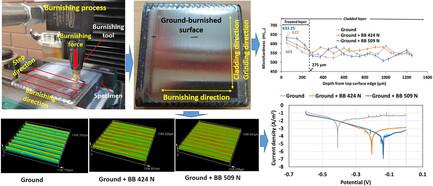当前位置:
X-MOL 学术
›
Adv. Eng. Mater.
›
论文详情
Our official English website, www.x-mol.net, welcomes your
feedback! (Note: you will need to create a separate account there.)
Effect of Combined Grinding–Burnishing Process on Surface Integrity, Tribological, and Corrosion Performance of Laser-Clad Stellite 21 Alloys
Advanced Engineering Materials ( IF 3.4 ) Pub Date : 2022-12-09 , DOI: 10.1002/adem.202201332 Mohammad Uddin 1 , Remi Santifoller 1, 2 , Colin Hall 3 , Thomas Schlaefer 4
Advanced Engineering Materials ( IF 3.4 ) Pub Date : 2022-12-09 , DOI: 10.1002/adem.202201332 Mohammad Uddin 1 , Remi Santifoller 1, 2 , Colin Hall 3 , Thomas Schlaefer 4
Affiliation

|
Herein, the influence of the grinding–burnishing on surface integrity, mechanical properties, and corrosion performance of Stellite 21 alloys coating deposited by laser cladding is investigated. The as-clad specimens are first ground followed by further modification by ball burnishing at forces of 424 N and 509 N. Results show that the grinding–burnishing enhances surface finish by lowering Ra from 2.6 to 0.73 μm and Rz from 13 to 4.9 μm, respectively. Surface porosity is found to decrease from 3.8% to 0.9%. Hardness is increased from 609 HV to 702 HV, with a surface alteration as deep as 250 μm, while wear resistance increases by reducing worn volume from 4.15 to 2.95 mm3. Because of high hardness, the grinding–burnishing increases impact resistance by lowering indent depth by 20%. Grains flatten and surface undulations are remarkably reduced due to burnishing. Finally, grinding–burnishing at 509 N improves the corrosion resistance by increasing positive corrosion potential from −0.41 to −0.14 V and lowering corrosion current density from 6.34 × 10−4 A cm−2 to 2.19 × 10−5 A cm−2, as compared to grinding. This synergistic grinding–burnishing can be a plausible post-treatment route for the laser-clad alloys.
中文翻译:

磨削-抛光联合工艺对激光熔覆 Stellite 21 合金表面完整性、摩擦学和腐蚀性能的影响
在此,研究了研磨-抛光对激光熔覆沉积的 Stellite 21 合金涂层的表面完整性、机械性能和腐蚀性能的影响。镀层试样首先经过研磨,然后在 424 N 和 509 N 的力下通过球抛光进一步改性。结果表明,研磨-抛光通过将 R a 从 2.6 降至 0.73 μm 和 R z 从 13降至4.9来提高表面光洁度微米,分别。发现表面孔隙率从 3.8% 降低到 0.9%。硬度从 609 HV 增加到 702 HV,表面变化深度达 250 μm,同时耐磨性通过将磨损量从 4.15 减少到 2.95 mm 3 而增加. 由于硬度高,磨削-抛光通过将压痕深度降低 20% 来提高抗冲击性。由于抛光,晶粒变平,表面起伏显着减少。最后,在 509 N 下进行研磨-抛光,通过将正腐蚀电位从 -0.41 增加到 -0.14 V 并将腐蚀电流密度从 6.34 × 10 -4 A cm -2降低到 2.19 × 10 -5 A cm -2来提高耐腐蚀性,与研磨相比。这种协同磨削-抛光可能是激光熔覆合金的一种合理的后处理途径。
更新日期:2022-12-09
中文翻译:

磨削-抛光联合工艺对激光熔覆 Stellite 21 合金表面完整性、摩擦学和腐蚀性能的影响
在此,研究了研磨-抛光对激光熔覆沉积的 Stellite 21 合金涂层的表面完整性、机械性能和腐蚀性能的影响。镀层试样首先经过研磨,然后在 424 N 和 509 N 的力下通过球抛光进一步改性。结果表明,研磨-抛光通过将 R a 从 2.6 降至 0.73 μm 和 R z 从 13降至4.9来提高表面光洁度微米,分别。发现表面孔隙率从 3.8% 降低到 0.9%。硬度从 609 HV 增加到 702 HV,表面变化深度达 250 μm,同时耐磨性通过将磨损量从 4.15 减少到 2.95 mm 3 而增加. 由于硬度高,磨削-抛光通过将压痕深度降低 20% 来提高抗冲击性。由于抛光,晶粒变平,表面起伏显着减少。最后,在 509 N 下进行研磨-抛光,通过将正腐蚀电位从 -0.41 增加到 -0.14 V 并将腐蚀电流密度从 6.34 × 10 -4 A cm -2降低到 2.19 × 10 -5 A cm -2来提高耐腐蚀性,与研磨相比。这种协同磨削-抛光可能是激光熔覆合金的一种合理的后处理途径。


















































 京公网安备 11010802027423号
京公网安备 11010802027423号